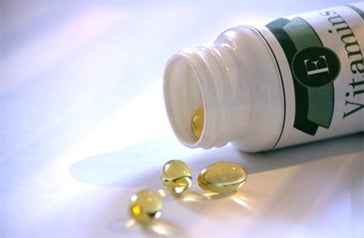Vitamin E, prostate cancer connection raises dosage questions
Yearly physicals and vitamin supplements aren’t top priorities for most men.
In fact, for many men, PSA stands for “patient-stimulated anxiety” not prostate-specific antigen, a common prostate cancer screening test conducted during yearly physicals, jokes E. David Crawford, M.D., investigator at the University of Colorado Cancer Center. Yet, last week’s news about vitamin E safety and PSA legitimacy left many men searching for the truth.
The SELECT trial found that men who took a high daily dose of vitamin E had a 17 percent greater risk of developing prostate cancer.
Results from the National Cancer Institute’s Selenium and Vitamin E Cancer Prevention Trial (SELECT) found that men who took a high daily dose of vitamin E had a 17 percent greater risk of developing prostate cancer.
“We now know there can be hazards from nutritional supplement use, so in future studies we should be more cautious about testing super-nutritional dose levels,” says Tim Byers, M.D., MPH, associate director for prevention and control at the CU Cancer Center and associate dean for public health practice at the Colorado School of Public Health. “If a little is good, a lot might be worse, not better.”
Started in 2001, the SELECT trial was developed to test whether antioxidant vitamins could reduce the risk of developing prostate cancer. More than 35,000 men age 50 and older were divided into four groups, and each are assigned a different supplement combination: vitamin E, selenium, both vitamin E and selenium, or a placebo pill.
Prior to the trial, previous studies indicated that vitamin E and selenium may protect against prostate cancer, but in 2008, SELECT participants were told to stop taking the supplements because researchers found they were not doing any good.
“At the time, studies needed to be done to see if selenium and vitamin E could impact prostate cancer, however, we’ve found it can’t be proven,” says Crawford, who also is a urologist at the University of Colorado Hospital. “(The SELECT trial) was a bust. It showed no effect on prostate cancer.”
There may not be a prostate cancer prevention method for some time, at least in the form of daily vitamin supplements. Byers’ best advice: Get your vitamins from foods, not supplements.
“This new evidence pointing to adverse effects for prostate cancer would lead me towards recommending that men do not take vitamin E supplements for disease prevention,” he says.
PSA testing dilemma
Screening for cancer is supposed to catch cancers early, ultimately saving more lives; but in the case of prostate cancer screening, many experts believe PSA screenings do more harm than good.
In early October, the U.S. Preventive Services Task Force downgraded its previous recommendation on prostate cancer screening for younger men, saying routine PSA tests for healthy men are not needed and do not save lives. Debates between doctors, insurance companies and policy makers are anticipated to continue, leaving patients without definitive answers.
New U.S. Preventive Services Task Force draft PSA recommendations are creating controversy in the medical world.
“While we’ve found more prostate cancer with screening, we couldn’t show that people are living longer as a result,” Crawford says. “We need to remember 28,000 men still die from prostate cancer every year, and we need to do something.”
Many physicians are stuck in a dilemma and wish there were a better way to diagnose and catch the most aggressive prostate cancers. The PSA does not distinguish between aggressive cancers and slow-growing ones, yet more accurate screening tools have not been released.
“Researchers are working diligently to develop new screening tools and markers for prostate cancer that we hope will better define the risk and aggressiveness of the disease,” Crawford says. “Until science has caught up with the tremendous need in prostate cancer, we can only make the best use of the tools and information we have available to us.”
As a father of three sons, Crawford still believes men should get a baseline PSA at 35. Then based on the results, they should develop a future testing plan that meets their needs.
“The PSA provides valuable information to them,” he says, “but it is in no way a diagnosis of the disease.”
Yet the question people want answered involves over-diagnosis and over-treatment. Are physicians doing more harm than good by screening?
While Crawford says over-treatment and over-diagnosis are true, “Most men don’t want to sit on their cancer. They want to do something.”
There’s a delicate balance between observing the cancer over time and performing surgeries right away. Instead of being treated immediately, men diagnosed with prostate cancer are now being observed and biopsied periodically to see if the cancer is worsening.
“A lot of people can be watched,” Crawford says. “The problem is the pathologist may have missed something in the biopsy and we need to watch this person.”
It’s the old Whitmore dilemma posed by Dr. Willet Whitmore, the father of urologic oncology: “For a patient with prostate cancer, if treatment for a cure is necessary, is it possible? If possible, is it necessary?”
“Patients should never undergo a treatment for prostate cancer because of the inherent fear of the word ‘cancer,’” Crawford says. “Rather, men should take the time to gather as much information as possible about their disease and develop an appropriate treatment plan that they understand and are comfortable with.”
When it comes to PSA screenings, the saga is about to become more intense. From now until Nov. 8, the U.S. Preventive Task Force is seeking public input on its proposed recommendations regarding PSA testing.
Will physicians welcome the screening recommendations with open arms or will it be business as usual? Time will tell.



